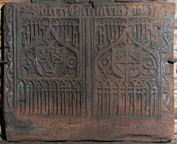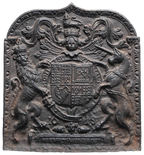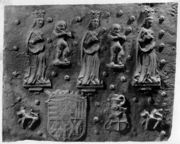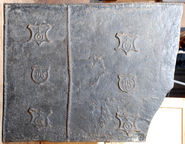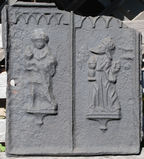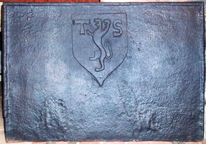-
810
Description: Rectangular; carved strip with undulating vine between fillets, repeated on each side; carved inscription panel along top edge; centre, two traceried panels, each with a central shield beneath a gothic arch.
Notes: One of several similar firebacks produced in the same period.
Copies of this fireback are known.
Inscription: JHESUS MARIA JHONES
- Decoration tags:
- rectangular (shape)
- fillet (edging)
- simple stamps
- carved stamps
- architectural
- armorial
- text
Manufactured: in the early-16th century possibly in the Eifel area of Germany.
Current location: in private hands, Cox Green, Berkshire, England.
- Attached to series:
- Foreign armorial firebacks
-
880
Description: Rectangular with ogee arch; ovolo, egg and dart edging; shield, garter, helm, mantling, crest and motto of the English House of Stuart; date split either side of garter buckle.
Notes: One of several firebacks, all of the same date, but varying in size, framing style and moulding; all have stylistic features in common and will have been the work of the same pattern maker, who was also responsible for carving royal coats of arms in three West Country churches. Similar in design but proportionately different to no. 1062. Christie's auction 19 Jun 2012 lot 191 (£1,750).
Copies of this fireback are known.
Inscription: HONI SOIT QVI MAL Y PENSE / 16 18 / DIEV ET MON DROIT
Arms: English Stuart royal (James I)
- Decoration tags:
- rectangular with ogee-arch (shape)
- ovolo, egg and dart (edging)
- whole carved pattern
- armorial
- text
Manufactured: in 1618 possibly in the Forest of Dean area of England.
Current location: not known.
-
1025
Description: Quasi-rectangular shape; top, crowned robed statuary figure holding a book, repeated three times, interspersed with a naked child statuary figure playing a flute; bottom, shield and coronet to left, small shield, helm and crest to right, all between a crude dog figure repeated on each side; the whole plate dotted randomly with a repeated small gadrooned bead stamp.
Notes: The figures are from wall-mounted statuary. The shield and coronet are those of the Duchy of Lorraine prior to 1538; blazon: Quarterly, 1. barry of eight gules and argent (Hungary) impaling azure semy-de-lis Or a label gules (Naples); 2. argent a cross potent and four crosslets Or (Jerusalem) impaling Or four pallets gules (Aragon); 3. azure semy-de-lis Or a bordure gules (Valois-Anjou); 4. azure crusilly fitchy, two barbels addorsed Or (Bar); overall an inescutcheon Or a bend gules three alerions argent (Lorraine). The figure holding the book is that of St Catherine of Siena (see von den Driesch, pp. 220, 222).
Arms: Duchy of Lorraine
- Decoration tags:
- rectangular (shape)
- none (edging)
- carved stamps
- heraldic
- historical
- armorial
- animals
- humans
- objects
Manufactured: in the early-16th century in the Lorraine area of Germany.
Current location: not known.
- Attached to series:
- Foreign armorial firebacks
-
176
Description: Probably originally rectangular; twisted rope edging (top and sides); two (originally probably three) panels divided by vertical twisted rope, each containing a rounded shield with fillet edge with 'ihs' (the 'h' crossed), between two cartouche-style shields with fillet edge, bearing a cross rising from two concentric rings.
Notes: The overtly religious symbolism may indicate a pre-Reformation or Marian date. The christogram, 'ihs', derived from the first three letters of 'IESUS' in Greek, was first noted in England in the 14th century. The cross rising from the rings may be intended to indicate christian dominion over the globe. Possibly as much as the right third of the fireback is missing. The fireback is believed to have been in Robertsbridge Abbey.
Inscription: ihs ihs
- Decoration tags:
- rectangular (shape)
- rope (edging)
- simple stamps
- carved stamps
- heraldic
- text
Manufactured: in the early-16th century possibly in the Weald area of England.
Current location: Hastings Museum and Art Gallery, John's Place, Bohemia Road, h, East Sussex, England.
Museum number: HASMG: 1914.38 (part of the Hastings Museum museum group)
- Attached to series:
- Religious firebacks
-
434
Description: Damaged; rectangle, flanged edging; two vertical panels, each with a row of lancet arches along the top: on right, robed figure with a crown, head tilted to left, left hand raised in benediction, right hand holding a chalice, standing on a bracket; on right, similar figure facing forward.
Notes: Stoveplate. Similar plates suggest these may be two of the Magi.
- Decoration tags:
- rectangular (shape)
- flanged (edging)
- simple stamps
- architectural
- humans
Manufactured: in the early-16th century in the Eifel area of Germany.
Current location: Anne of Cleves House, Southover High Street, Lewes, East Sussex, England.
Museum number: LH000.795 (part of the Sussex Archaeological Society museum group)
Citation: Dawson, C., 1903, 'Sussex Iron Work and Pottery', Sussex Archaeological Collections, 46, pp. 1-54.
- Attached to series:
- Stoveplates
- Figurine firebacks
-
859
Description: Rectangular; twisted rope edging (to and sides); top centre, shield bearing a lion rampant with two heads, between split initials.
Notes: The heraldic charge of a lion rampant with two heads is rare, the only documented family with which it is associated being that of Mason, of Yorkshire, to whom this shield does not seem to apply.
Inscription: TS
Arms: Not known
- Decoration tags:
- rectangular (shape)
- rope (edging)
- carved stamps
- heraldic
- armorial
- text
Manufactured: in the early-16th century in England.
Current location: not known.
- Attached to series:
- Personal armorial firebacks
